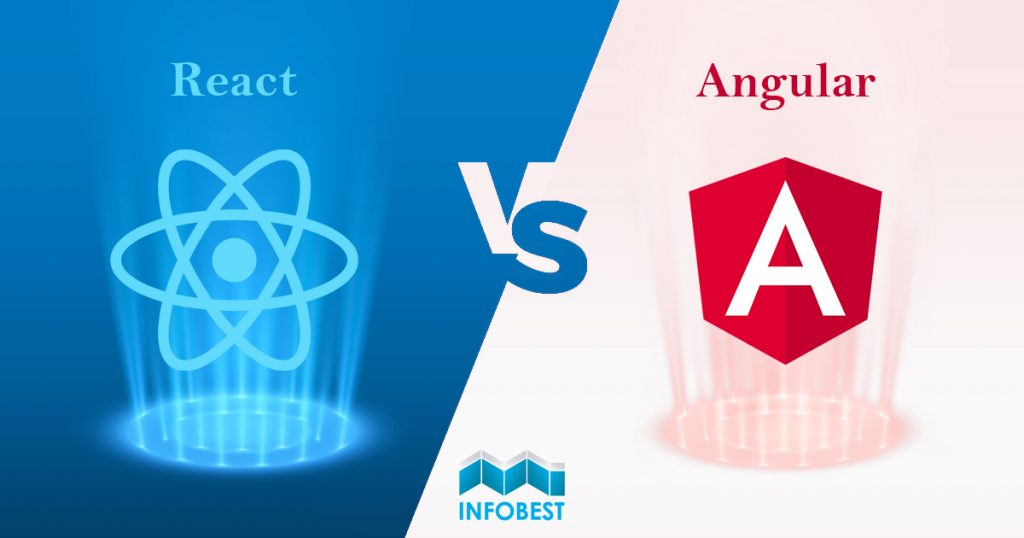As technology continues to advance rapidly, the field of web development experiences exponential growth. Within the expansive JavaScript ecosystem, two frameworks stand out prominently: Angular and React. Renowned for their versatility and widespread adoption, these frameworks have become the go-to choices for front-end development. If we look at the Stack Overflow 2022 survey, we can observe that among web frameworks, 42.6% of respondents prefer React, while 20.3% use Angular instead. However, selecting the ideal framework between these two is no easy task. Let’s delve into the key differentiators and understand which framework aligns best with your development requirements.
React: A Lightweight and Flexible Option
React is a JavaScript library used for building user interfaces. Developed by Facebook, React is designed to efficiently render and update UI components, providing a seamless and interactive experience for web applications. It is known for its lightweight nature and flexibility, making it a preferred choice for many developers. Therefore, it’s no wonder why React is powering milions of websites , and with countless new websites launching each day, its popularity continues to soar.
Here are the key features and advantages of using React for Java software development:
Virtual DOM and Performance:
React utilizes a virtual DOM (Document Object Model), a lightweight copy of the actual DOM. This approach allows React to efficiently update only the necessary components when changes occur, resulting in improved application performance. React’s reconciliation algorithm intelligently handles updates, reducing unnecessary re-rendering and enhancing the overall user experience. This performance optimization makes this framework suitable for applications that require high responsiveness and real-time updates.
Component-Based Architecture:
One of React’s core concepts is its component-based architecture. Developers can create reusable UI components with React, allowing for modular and maintainable code. Components in React encapsulate both the structure and behavior of specific parts of the user interface, enabling easy reusability across different sections of an application. This reusability improves development efficiency, reduces code duplication, and facilitates collaboration among team members.
React Native:
React’s versatility extends beyond web development. React Native, a framework built upon React enables the development of cross-platform mobile applications using JavaScript. This allows your Java outsourcing company to leverage existing skills and codebase, resulting in faster time-to-market and cost savings. With React Native, you can build native mobile apps that perform well on both iOS and Android platforms while sharing a significant portion of the codebase.
Angular: A Comprehensive Framework for Scalability
Angular, developed and maintained by Google, is a comprehensive JavaScript framework specifically designed for building dynamic web applications. It provides a complete toolkit of features and tools necessary for developing robust and scalable applications, particularly suited for large-scale projects. It follows a structured approach and offers a powerful set of functionalities out of the box.
Here are some key features and advantages of using Angular for Java software development:
TypeScript and Strong Typing in Angular:
One of the standout features of Angular is its utilization of TypeScript, a statically-typed superset of JavaScript. By incorporating “static typing,” TypeScript requires explicit declaration of data types for variables, function parameters, and return values during development. This proactive approach catches errors at compile-time, resulting in more dependable code and enhanced code maintainability, particularly beneficial in larger codebases. TypeScript’s robust static typing also provides developers with improved tooling support, facilitating faster and more accurate coding, while reducing the likelihood of runtime errors.
Full-Fledged Framework:
Angular is known for being a comprehensive framework that includes a broad range of features out of the box. It provides built-in support for essential functionalities like dependency injection, routing, form handling, and testing utilities. This comprehensive approach reduces the need for integrating third-party libraries, simplifying the development process and ensuring consistency in the codebase.
Two-Way Data Binding:
Angular’s powerful two-way data binding simplifies the synchronization between the model and the view. With two-way data binding, changes made in the model automatically reflect in the view, and vice versa. This feature eliminates the need for manual manipulation of the DOM, reducing the amount of code required for data handling and ensuring consistency throughout the application.
Differences between React and Angular
These two widely adopted JavaScript frameworks for web application development exhibit notable differences in various aspects:

Architecture
React: follows a component-based architecture, where UI elements are divided into reusable components. These components manage their own state and can be combined to build complex user interfaces.
Angular: follows a full-fledged framework architecture, offering a comprehensive structure and opinionated approach to application development. It provides built-in solutions for various aspects, including routing, form handling, and dependency injection.
Learning Curve
React: has a relatively easier learning curve, especially for developers already familiar with JavaScript. It is less opinionated, allowing developers to have more flexibility and control over the code structure.
Angular: has a steeper learning curve, particularly for developers new to TypeScript or framework-specific concepts. It has a more structured approach and requires an understanding of Angular-specific concepts like decorators, modules, and dependency injection.
Language
React: can be written in JavaScript ES6+ combined with JSX script, which consists of an extension for syntax, making JavaScript code look similar to HTML. In order to compile the JSX code in a browser, React can be augmented with a code translation tool (e.g., Babel). Additionally, React can also be written in TypeScript, but it is not included natively.
Angular: can use TypeScript, a superset of JavaScript, and a statically typed language. In TypeScript, typos are easier to spot, and overall, the code is easier to navigate. This enhances code maintainability, provides better tooling support, and helps catch errors during the development process.
Ecosystem
React: has a vibrant ecosystem with a large number of third-party libraries and community-driven tools. It offers great flexibility in choosing additional libraries and integrating them into your project.
Angular: provides a comprehensive ecosystem with many built-in features and tools. It includes a rich set of functionalities out of the box, reducing the need for external libraries.
Performance
React: utilizes a virtual DOM and employs efficient diffing algorithms, making it highly performant. It updates only the necessary components, resulting in faster rendering and improved overall performance.
Angular: performance is also commendable, thanks to its change detection mechanism and zone.js library. However, the full-fledged nature of Angular may lead to slightly larger bundle sizes compared to React.
Community and Popularity
React: has gained immense popularity and has a vast community support base. It is widely adopted by many tech companies and has a large number of open-source contributions and resources available.
Angular: backed by Google, also has a significant community support base. It has been used in various enterprise-level applications and has its own set of dedicated followers.
Ultimately, the choice between React and Angular depends on the specific needs of your project, the size of the development team, and the desired level of structure and opinionation. Both frameworks have their strengths and are suitable for different use cases.
Angular vs. React: Making the Right Choice for Your Project
So, which technology should you choose? The decision between ReactJS and Angular depends on various factors such as the required features, project requirements, and personal preferences.
Opt for React JS if:
- You aim to build dynamic web applications and desire more flexibility in designing the application’s architecture.
- Time is of the essence, and you have tight deadlines. React is relatively easier and simpler for young professionals compared to frameworks like Angular. It utilizes the virtual DOM, a key feature that accelerates development speed.
- You value a component-driven architecture approach. React’s emphasis on reusable components allows you to efficiently build and reuse elements across projects, serving as an investment in future endeavors. By leveraging existing code, you can expedite development, and testing, and reduce costs for new progressive web apps.
Choose Angular for your project if:
- You intend to create a substantial application. Angular offers a pre-built framework with an MVC structure, streamlining and expediting the development process significantly.
- Scalability is a crucial requirement. Angular provides an environment that allows for easy and reliable scalability, making it well-suited for projects with future growth potential.
- Ultimately, both ReactJS and Angular have their unique strengths and applications. Consider your project’s specific needs and the expertise of your development team to make an informed decision that aligns with your project’s goals and objectives.
Final thoughts
Both frameworks have their own advantages and cater to different development requirements. React’s lightweight nature and flexibility make it ideal for projects where performance and modularity are critical. On the other hand, Angular’s comprehensive framework and strong typing provide a robust foundation for large-scale applications.
Consider the specific needs of your software development project and evaluate factors such as project size, complexity, and team expertise when choosing between React and Angular. Remember, the success of your software development relies on selecting the framework that aligns best with your requirements and goals.
By partnering with a reliable Java software development company, you can leverage the expertise of experienced developers who are well-versed in both React and Angular. Their knowledge and insights can guide you in making an informed decision and ensure the successful delivery of your Java software projects.

